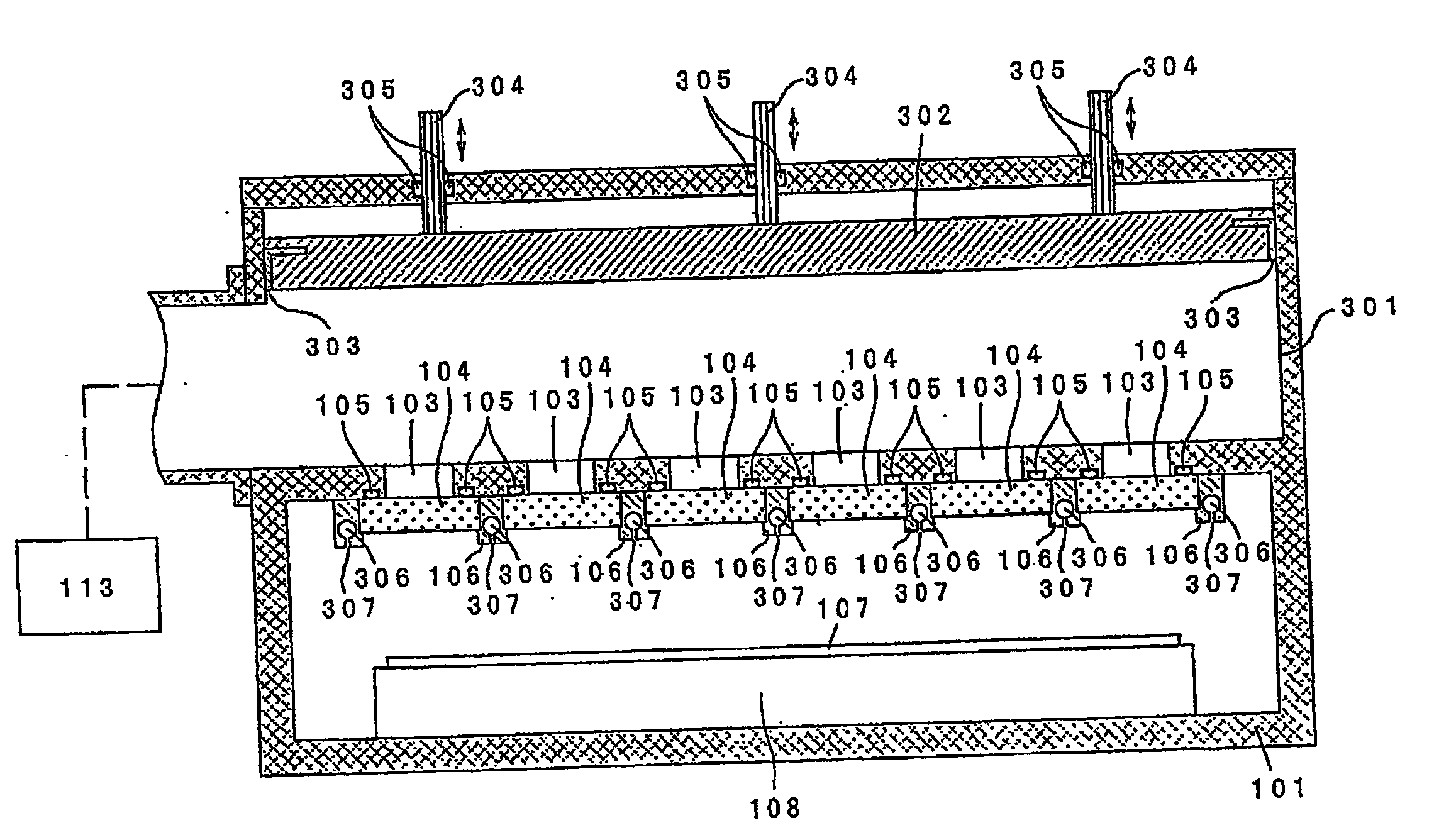Plasma Processing Apparatus
a processing apparatus and plasma technology, applied in the field of plasma processing apparatus, can solve the problems of affecting the uniformity of the plasma, the actual guide wavelength does not completely agree with the design value, and the limitations of obtaining a uniform plasma, etc., to achieve the effect of reducing the size, flexibly coping, and facilitating the acquisition of uniform plasma
- Summary
- Abstract
- Description
- Claims
- Application Information
AI Technical Summary
Benefits of technology
Problems solved by technology
Method used
Image
Examples
embodiment 1
[0036]FIG. 1 is a sectional view showing the first embodiment among the plasma processing apparatuses of this invention. FIG. 2 is a sectional view taken along A-A in FIG. 1 and FIG. 3 is a sectional view taken along B-B in FIG. 1.
[0037]A vacuum container 101 is made of, for example, aluminum and is in a state of being grounded. A substrate 107 and a stage 108 for the substrate 107 are provided in the vacuum container 101. The substrate 107 is, for example, a glass substrate. A bellows 109 is provided between the stage 108 and the vacuum container 101, so that the stage 108 can be moved up and down by a non-illustrated elevator mechanism while maintaining airtightness. In the lower part of the vacuum container 101, there are provided exhaust ports 110 for exhausting gas in the vacuum container 101 by the use of a vacuum pump or the like provided outside the vacuum container 101.
[0038]Two rectangular waveguides 102 are disposed in parallel to each other, i.e. with their H surfaces (w...
embodiment 2
[0075]FIG. 9 is a sectional view showing the second embodiment among the plasma processing apparatuses of this invention. Herein, only what is different from the first embodiment will be described.
[0076]On the surface of each waveguide 102 on the side of a stage 108, rectangular parallelepiped dielectric plates 104 are disposed in one-to-one correspondence with slots 103. It may be configured that each dielectric plate 104 may be arranged so as to lie over the plurality of waveguides 102.
[0077]An in-waveguide dielectric 201 is provided in each waveguide 102. The in-waveguide dielectric 201 is made of a fluororesin having a relative permittivity of 2.1, but may be made of quartz, mullite, alumina, sapphire, yttria, aluminum nitride, silicon nitride, or the like. If the dielectric is inserted in the waveguide as described above, the size of a waveguide section and the guide wavelength λg are reduced. Given that the relative permittivity of an in-waveguide dielectric is “∈r”, the size ...
embodiment 3
[0084]FIG. 11 is a sectional view showing the third embodiment among the plasma processing apparatuses of this invention. FIG. 12 is a sectional view taken along A-A in FIG. 11. Herein, only what is different from the first embodiment will be described.
[0085]A single rectangular waveguide 301 is disposed with its E surfaces (narrow wall surfaces of the rectangular waveguide) being parallel to a substrate 107. The waveguide 301 has one end forming a short-circuit surface and the other end to which a microwave supply system 113 is connected. In this embodiment, since an elongated plasma can be produced, it is suitable for the case where plasma processing is carried out for an elongated member or the case where plasma processing is carried out while moving a large-area substrate in a direction perpendicular to the axis of the waveguide.
[0086]A plurality of slots 103 are formed at regular intervals in a surface, on the side of a stage 108, of the waveguide 301. On the surface of the wav...
PUM
| Property | Measurement | Unit |
|---|---|---|
| Length | aaaaa | aaaaa |
| Length | aaaaa | aaaaa |
| Length | aaaaa | aaaaa |
Abstract
Description
Claims
Application Information
 Login to View More
Login to View More - R&D
- Intellectual Property
- Life Sciences
- Materials
- Tech Scout
- Unparalleled Data Quality
- Higher Quality Content
- 60% Fewer Hallucinations
Browse by: Latest US Patents, China's latest patents, Technical Efficacy Thesaurus, Application Domain, Technology Topic, Popular Technical Reports.
© 2025 PatSnap. All rights reserved.Legal|Privacy policy|Modern Slavery Act Transparency Statement|Sitemap|About US| Contact US: help@patsnap.com



